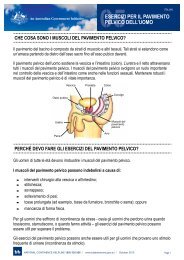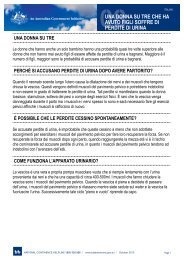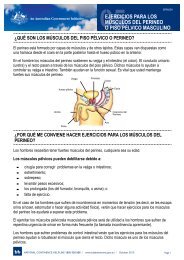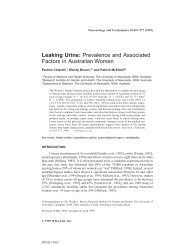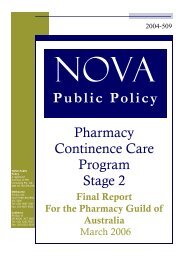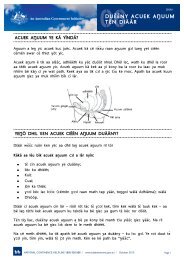Continence Tools for Residential Aged Care - Bladder and Bowel ...
Continence Tools for Residential Aged Care - Bladder and Bowel ...
Continence Tools for Residential Aged Care - Bladder and Bowel ...
You also want an ePaper? Increase the reach of your titles
YUMPU automatically turns print PDFs into web optimized ePapers that Google loves.
Symptoms or factors<br />
that warrant further<br />
attention<br />
Rationale<br />
Straining to use bowels Some straining to use bowels is normal. Excessive straining indicates constipation<br />
<strong>and</strong>/or an underlying pathology (i.e. neuropathic damage). Keep in mind that people<br />
with chronic health conditions may have difficulty in achieving abdominal pressure<br />
that facilitates bowel clearance.<br />
Bleeding when using<br />
bowels<br />
Bleeding during defeacation is not normal. It may indicate haemorrhoids or other<br />
underlying pathology.<br />
Hard, dry bowel motions <strong>Bowel</strong> motions should be soft <strong>and</strong> <strong>for</strong>med. Refer to the Bristol Stool Form Scale<br />
<strong>for</strong> assistance in differentiating between a healthy <strong>and</strong> unhealthy motion. There are<br />
numerous factors that result in motions that are too hard (i.e. medication side effects,<br />
Very fluid bowel motions<br />
inadequate fluid, exercise <strong>and</strong> fibre) or in motions that are too loose (i.e. diet, irritable<br />
bowel syndrome, gastroenteritis, medication side effects etc).<br />
Urine Ph 7 is the point of neutrality on the pH scale. The lower the pH, the greater the acidity of a<br />
solution; the higher the pH, the greater the alkalinity. Urine pH is an important screening<br />
test <strong>for</strong> the diagnosis of renal disease, respiratory disease, <strong>and</strong> certain metabolic<br />
disorders. Depending on the person’s acid-base status, the pH of urine may range from<br />
4.5 to 8. Levels above or below this range warrant attention.<br />
Urine specific gravity Specific gravity measures the kidney’s ability to concentrate or dilute urine in relation<br />
to plasma. Because urine is a solution of minerals, salts, <strong>and</strong> compounds dissolved in<br />
water, the specific gravity is greater than 1.000. The more concentrated the urine, the<br />
higher the urine specific gravity. A low specific gravity may indicate renal disease <strong>and</strong><br />
certain metabolic disorders (i.e. diabetes insipidus). The normal specific gravity range<br />
in urine is 1.020 -1.030 g/ml. Levels above or below this range warrant attention.<br />
Blood in urine Otherwise known as ’haematuria,’ blood in the urine can be visible to the naked eye or<br />
it may be microscopic. There are many possible causes of haematuria including urinary<br />
tract infection, inflammation/infection of the prostate, stones, <strong>and</strong> injury to any part of<br />
the urinary tract, excessive exercise, certain medications, (i.e. blood thinning agents),<br />
kidney disease, <strong>and</strong>/or cancer of the kidney, prostate or bladder. If the resident has<br />
haematuria, it should be promptly investigated.<br />
Nitrates in urine Under normal conditions, urine is sterile <strong>and</strong> free from bacteria, viruses <strong>and</strong> fungi.<br />
The presence of nitrites in urine indicates a urinary tract infection.<br />
This should be further investigated.<br />
Leukocytes in urine The presence of leukocytes in urine is indicative of a urinary tract infection.<br />
This should be further investigated.<br />
Impaired skin integrity If the resident has impaired skin integrity, they will require a care plan that specifically<br />
addresses this issue. A Wound <strong>Care</strong> Consultant may be able to provide additional<br />
advice <strong>and</strong> assistance.<br />
25



